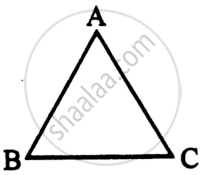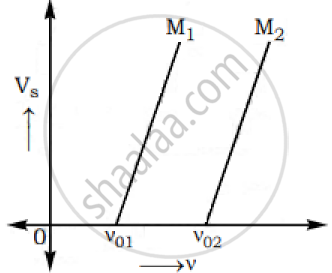Advertisements
Advertisements
Question
The energy of photon of wavelength X is_____ .
[h = Planck’s constant, c = speed of light in vacuum]
Options
hcλ
`(hλ)/c`
`λ/(hc)`
`(hc)/λ`
Solution
`(hc)/lambda`
Energy of a photon E =`hv=(hc)/lambda`
APPEARS IN
RELATED QUESTIONS
The momentum of a photon of de Broglie wavelength 5000Å is _______.
[Planck’s constant = 6.63 x10-34 J.s.]
Find the value of energy of electron in eV in the third Bohr orbit of hydrogen atom.
(Rydberg's constant (R) = 1· 097 x 107m - 1,Planck's constant (h) =6·63x10-34 J-s,Velocity of light in air (c) = 3 x 108m/ s.)
Find the wave number of a photon having energy of 2.072 eV
Given : Charge on electron = 1.6 x 10-19 C,
Velocity of light in air = 3 x 108 m/s,
Planck’s constant = 6.63 x 10-34 J-s.
Write Einstein's photoelectric equation and mention which important features in photoelectric effect can be explained with the help of this equation.
The maximum kinetic energy of the photoelectrons gets doubled when the wavelength of light incident on the surface changes from λ1 to λ2. Derive the expressions for the threshold wavelength λ0 and work function for the metal surface.
A proton and a deuteron are accelerated through the same accelerating potential. Which one of the two has less momentum?
Give reasons to justify your answer.
Write its S.I. unit of (intensity of radiation)
The work function for a metal surface is 2.2eV. If the light of wavelength 5000Å is incident on the surface of the metal, find the threshold frequency and incident frequency. Will there be an emission of photoelectrons or not? (c = 3 x 108 m/ s, 1eV = 1.6x10-19 J , h = 6.63 x 10-34 J.s.)
Write Einstein’s photoelectric equation.
Which of the following graphs correctly represents the variation of maximum kinetic energy (Ek) of photoelectrons with the frequency (𝜈) of the incident radiation?
Plot a labelled graph of |Vs| where Vs is stopping potential versus frequency f of the incident radiation. State how will you use this graph to determine the value of Planck's constant?
In an inelastic collision, which of the following does not remain conserved?
Radiations of two photon's energy, twice and ten times the work function of metal are incident on the metal surface successively. The ratio of maximum velocities of photoelectrons emitted in two cases is:
A 200 W sodium street lamp emits yellow light of wavelength 0.6 µm. Assuming it to be 25% efficient in converting electrical energy to light, the number of photons of yellow light it emits per second is:
Dimensions of ‘resistance’ are same as (where h is Planck's constant and e is charge):
Einstein work on the photoelectric effect provided support for the eqn:-
Who indirectly determined the mass of the electron by measuring the charge of the electrons?
If the frequency of light in a photoelectric experiment is double the stopping potential will
If the energy of photon corresponding to a wavelength of 6000 A° is 3.32 × 10-19 J, the photon energy for a wavelength of 4000 A° will be
The slope of frequency of incident light and stopping potential for a given surface will be
Which of the following is/are true for cathode ray
The wavelength of matter is independent of
(i) A ray of light incident on face AB of an equilateral glass prism, shows minimum deviation of 30°. Calculate the speed of light through the prism.

(ii) Find the angle of incidence at face AB so that the emergent ray grazes along the face AC.
- Calculate the frequency of a photon of energy 6.5 × 10−19 J.
- Can this photon cause the emission of an electron from the surface of Cs of work function 2.14 eV? If yes, what will be the maximum kinetic energy of the photoelectron?
Ultraviolet light is incident on metals P, Q and R, having work functions 8 eV, 2 eV and 4 eV respectively,
- Which metal has lowest threshold frequency for photoelectric effect?
- For which metal is the value of Emax minimum?
(Note: Emax is maximum kinetic energy of the emitted photoelectrons.)
The graphs below show the variation of the stopping potential VS with the frequency (ν) of the incident radiations for two different photosensitive materials M1 and M2.

Express work function for M1 and M2 in terms of Planck’s constant(h) and Threshold frequency and charge of the electron (e).
If the values of stopping potential for M1 and M2 are V1 and V2 respectively then show that the slope of the lines equals to `(V_1-V_2)/(V_(01)-V_(02))` for a frequency,
ν > ν02 and also ν > ν01
